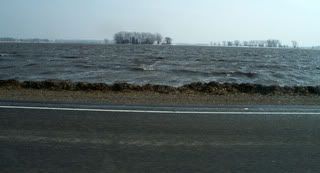 A river channel is forever adjusting its path through the landscape, even in the face of man's best attempts to contain it. Our river is no longer wild; it is part of an integrated and efficient farm drainage system. But even this drainage ditch is not static. After every high water event, the current widens the outside bends and scours out deeper pools. Weak banks slough down and trees tumble with them. This most recent flood picked up debris from miles upstream and piled it in the floodplain forest. Corn stalks and cobs, wheat straw, rotten sugar beets, and birch bark collected in mounds wrapped around tree trunks. New ridges of sand and silt lie on the banks, covered in mottled patterns. The new look is only temporary, as the river continues to flow, always changing.
A river channel is forever adjusting its path through the landscape, even in the face of man's best attempts to contain it. Our river is no longer wild; it is part of an integrated and efficient farm drainage system. But even this drainage ditch is not static. After every high water event, the current widens the outside bends and scours out deeper pools. Weak banks slough down and trees tumble with them. This most recent flood picked up debris from miles upstream and piled it in the floodplain forest. Corn stalks and cobs, wheat straw, rotten sugar beets, and birch bark collected in mounds wrapped around tree trunks. New ridges of sand and silt lie on the banks, covered in mottled patterns. The new look is only temporary, as the river continues to flow, always changing.
Monday, March 30, 2009
The aftermath
 A river channel is forever adjusting its path through the landscape, even in the face of man's best attempts to contain it. Our river is no longer wild; it is part of an integrated and efficient farm drainage system. But even this drainage ditch is not static. After every high water event, the current widens the outside bends and scours out deeper pools. Weak banks slough down and trees tumble with them. This most recent flood picked up debris from miles upstream and piled it in the floodplain forest. Corn stalks and cobs, wheat straw, rotten sugar beets, and birch bark collected in mounds wrapped around tree trunks. New ridges of sand and silt lie on the banks, covered in mottled patterns. The new look is only temporary, as the river continues to flow, always changing.
A river channel is forever adjusting its path through the landscape, even in the face of man's best attempts to contain it. Our river is no longer wild; it is part of an integrated and efficient farm drainage system. But even this drainage ditch is not static. After every high water event, the current widens the outside bends and scours out deeper pools. Weak banks slough down and trees tumble with them. This most recent flood picked up debris from miles upstream and piled it in the floodplain forest. Corn stalks and cobs, wheat straw, rotten sugar beets, and birch bark collected in mounds wrapped around tree trunks. New ridges of sand and silt lie on the banks, covered in mottled patterns. The new look is only temporary, as the river continues to flow, always changing.
Thursday, March 26, 2009
The cold returns

Roads are closed in all directions, but a morning of 18 degrees (F) allowed us to escape on frozen mud to the post office. The surrounding fields now resemble the Arctic Ocean. The local water levels dropped far enough to open the floodgate on our culvert, draining the icy pond in the yard. But we still wait and watch downstream. Most of our business is conducted in Fargo-Moorhead, and those communities are in a mad dash to keep up with ever-rising crest predictions from the NWS and USGS. Traffic is a mess and some neighborhoods are under evacuation.
Wednesday, March 25, 2009
The crest
Our river crested yesterday, for the first time anyway. It receded almost a foot overnight. Unfortunately, a winter storm blew in and dropped three or four inches of snow before daybreak. Our gravel road is almost passable again, but now the highways are treacherous. Downstream, the Red is still rising. Public officials issue contradictory announcements, calling for more volunteers and advising no travel.
Tuesday, March 24, 2009
The island

It feels strange to hear the birds singing so happily while the river surrounds us with cold brown water. To them, this must be paradise. There is a large flock of geese honking in the body of water that pours over our road. The juncoes are bathing in our yard and picking through last year's sunflowers. Robins hop around the water's edge, occasionally reaching down for something edible. Trees with wet feet have blackbirds in the dry top branches. A red squirrel chatters from the roof of the shed. The county placed roadblocks on both sides of us and most gawkers turn back. It has been quiet and peaceful for most of the island residents today.
The road

The gravel road going north to the highway is under water, and not just a little water. There is a torrent of water, driven by the high winds, eating the road away. It doesn't help that there is a pile of ice chunks and corn stalks jammed up at the bridge, damming the river flow. For the moment, this road is still open to the south. We can probably get out that way. But if we get out, will we make it back in?
Monday, March 23, 2009
The sump pumps

The river creeps higher. If we had any chickens left, they would be sleeping in the willow trees. There is too much water collecting on the wrong side of the flood dike. If the heavy rain hits us, we will need to start pumping it out of the yard and into the swollen river. As it is, the sump pumps have been humming every 15 minutes to keep the basement "dry." Dry is a relative term in these conditions. But everything still works in the house and we still have access to the highway. I wonder what tomorrow will bring?
The rainfall

This is one of Minnesota's new lakes. It used to be a soybean field. The rain started to fall last night. There hasn't been a lot of rain yet, but any rain is bad news. The snowmelt has nowhere to go and the rain will just add to the standing water. Rivers are rising faster now, and local town leaders are pleading with residents to stop using any water appliances. I stopped at a hardware store this morning to get a coupler for our back-up sump pump. A woman there was angry because the sewer drain plugs were sold out. She couldn't find one anywhere. A man suggested that she use a soccer ball or a basketball. The woman stormed out. At the grocery store, people were stocking up on bottled water and soda.
Sunday, March 22, 2009
The slow rise

I opened the floodgate on our culvert last night to drain the pond forming in our front yard. The gate will now remain closed until after the river crests. The river has risen up above the mouth of the culvert this morning and we don't want the water to back up into our yard. The metal machine shed above houses my parents' boat and my canoe. If the need (and river) arises, we can use the boat or the canoe to make our escape. I doubt it will come to that.
For now, the floodwaters can be appreciated for the habitat they are creating for spawning fish and migrating flocks of waterfowl. A pair of wood ducks were dabbling just a stone throw from our bathroom window.
Friday, March 20, 2009
The spring thaw


Today is the first day of spring. This is a time for renewed optimism in the Red River Valley, but it is tempered by caution because the spring melt is also a time for the annual flood. The Red River of the North and every tributary to this great river, large and small, fills up with cold water from the snowdrifts that formed over the past four or five months. Some years, like this one, we also have to consider the rainwater held frozen in the soil from the previous fall.
We live on a small river that feeds the Red. This river serves as the drainage ditch for many square miles of flat farmland. The banks overflow on a regular basis from major rain events, so you can imagine what a record year of snowmelt will do. Our house is surrounded by a tall earthen dike; this structure was built after the big flood of 1997. But the National Weather Service and the USGS suggest that this year's flood could be bigger. This blog is my attempt to document the flood of 2009.
Subscribe to:
Posts (Atom)

